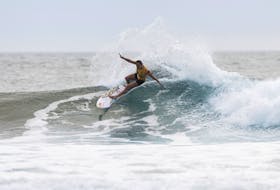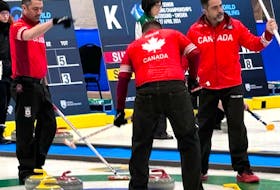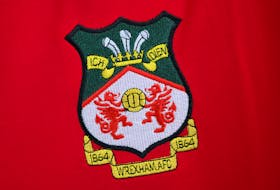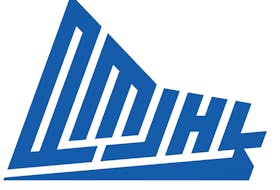LIVERPOOL – Chants and cheers echoed through the arena at Queens Place Emera Centre Jan. 27 and 28.
Skaters from all over Atlantic Canada were in Liverpool for the 2018 Atlantic Canada Synchronized Skating Championships, and the energy of the crowd could almost be felt, says Victoria Hopper. She says that feeling is what’s different about a synchronized skating competition from a regular one.
Hopper, who turns 20 in February, began to skate when she was nine with the Yarmouth Skating Club. A couple of years later, Hopper joined the Queens County Blades when her family moved to Liverpool.
“I was here from Grade 6 until I graduated,” explained Hopper from Queens Place’s busy lobby.
What made Hopper want to pull on a pair of figure skates and hit the ice? It was the 2006 Olympics.
“Sasha Cohen was skating, and I watched her, and I was like, ‘Wow, that’s so crazy. I want to do that,’” she said.
In synch
Once Hopper graduated from high school, she knew she wanted to keep skating. She also knew Acadia University had a team. That’s how Hopper became a synchronized figure skater.
Her team, which she’s been with for two years now, is the Acadia Axe-Elles. On the team are 16 skaters and an alternative.
“I find it’s a lot less nerve-racking, too, because you’re there with all of your friends,” said Hopper, adding to what makes a synchro competition different.
Hopper says one of the more challenging aspects of the sport was at first getting used to skating so close to other people. There’s somebody next to you the entire time.
“That was tricky to get used to after skating by myself for all those years,” she said.
Remembering all the little details is not easy either, she said.
Skaters have a year to fine-tune those details and more. That’s how long it takes to prepare a routine. The Acadia Axe-Elles practice regularly twice a week, but Hopper says whenever they can get ice time, they’re out there working on their routines.
At the beginning of the year, there’s a tryout, when every skater can show what she’s capable of doing.
“And then we pick a team based on that.”
Once the team has been chosen, much of the work is on basic skating skills.
“So everybody gets used to who’s on the team and how to skate next to people, and that kind of thing,” said Hopper. “(For) lots of people it’s their first time skating synchro when they come here, so we really have to start from the basics.”
In October, the team has a choreography weekend, which entails learning all the steps to the program.
The team aspect is one of the things Hopper likes most about practicing her sport. She says she and the other skaters are like family.
Though the Acadia Axe-Elles were hoping to earn a spot to head to the National Synchronized Skating Championships, they ended up with a silver medal in the competition and won’t be heading to nationals this year, set to take place in Oshawa, Ont. from Feb. 23-25.
The winners, based on their performances at the 2018 Atlantic Canada Synchronized Skating Championships, include Genesis in intermediate, Synergy in novice and the Starlites in the open category.
Behind the scenes
There are lots of off-ice jobs at a skating competition, and one of those is to judge the routines. Allison Scott was one of the judges at the 2018 Atlantic Synchronized Skating Championships.
“There are two different sides to the judging panel,” explained Scott.
There’s a technical side, which gives each element a level. The judging side gives a mark according to the quality. And then there are the data specialists who do the calculations to get final scores.
“The big difference is now teams are usually eight to 16 skaters, so there are a lot more people on the ice. There are a lot more moving parts that you’re looking at,” said Scott, describing what’s unique about judging synchronized skating.
There are fewer jumps and spins, so judges are watching how teams work together. They’re also watching the shapes teams are creating – circles and lines, for example.
Scott was a figure skater when she was younger and did some synchronized skating in university. She says the sport is good for those who want to continue to figure skate as adults.
After moving from Newfoundland to Nova Scotia about 11 years ago, Scott got involved with figure skating and judging.
Becoming a judge involves attending seminars, writing exams and being mentored.
What Scott particularly enjoys about judging synchronized skating is similar to what Hopper enjoys about being a synchronized skaters. It’s the energy in the arena.
Scott loves to watch young skaters doing a sport they love and hopes it’s something they’ll continue to do.
Go online: Visit the Skate Canada website at https://skatecanada.ca/
for more information about what’s happening in figure skating.
Did you know?
The following teams earned the following medals:
Pre-novice:
Bronze: Charlottetown Rockettes (Charlottetown Skating Club)
Silver: Ice Crystals (Evangeline Figure Skating Club)
Gold: Genesis (Conception Bay South Skating Club)
Novice:
Silver: Revolution (Kentville Silver Gliders)
Gold: Synergy (Prince of Whales Skating Club)
Intermediate:
Bronze: Riverview Royalty (Riverview Skating Club – New Brunswick)
Silver: Synergy (Prince of Whales Skating Club)
Gold: Genesis (Conception Bay South Skating Club)
Open:
Bronze: Charlottetown Panthers (Charlottetown Skating Club)
Silver: Acadia Axe-Elles (Wolfville Skating Club)
Gold: Starlites (Mount Pearl-Paradise)








